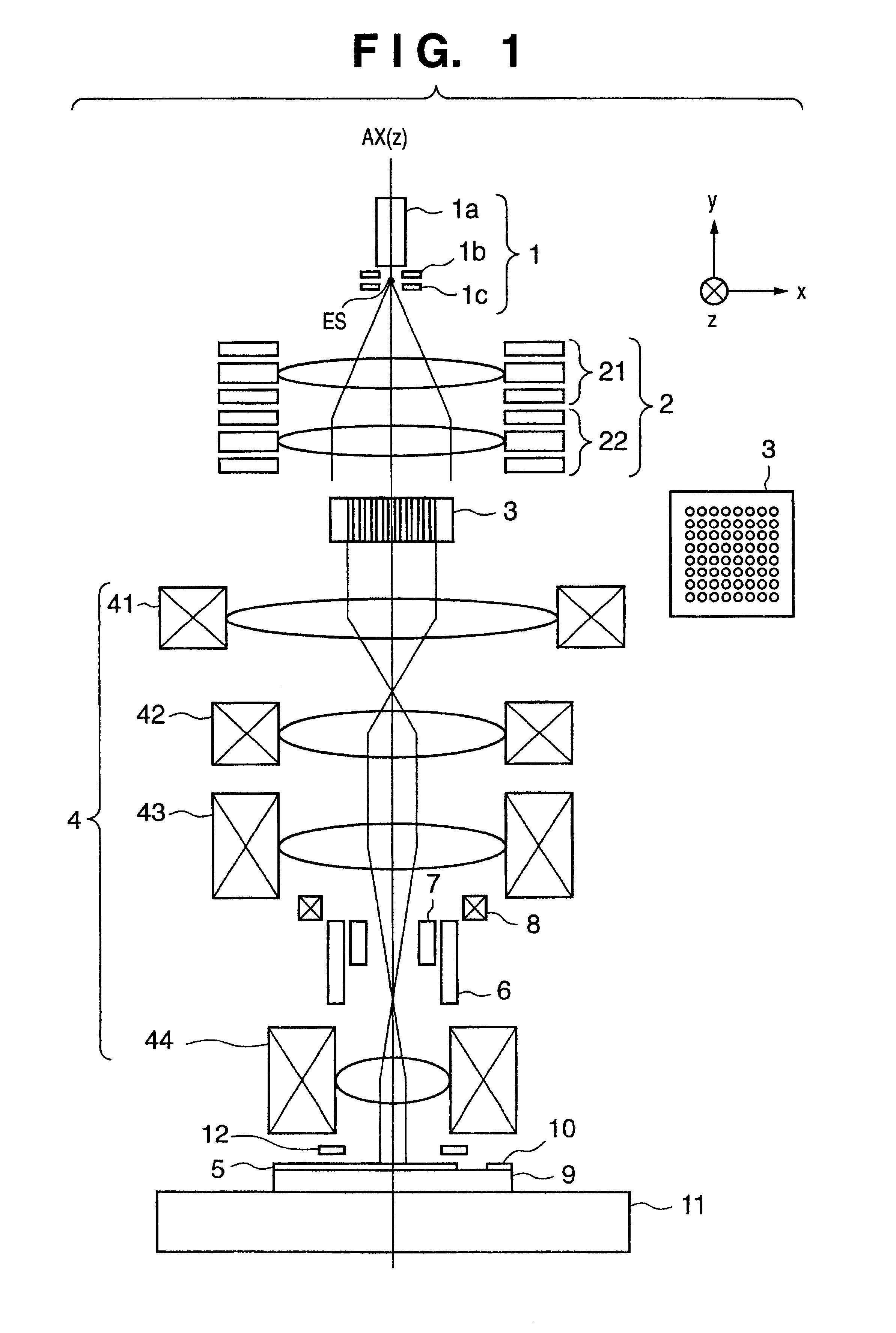Charged particle beam exposure apparatus and method
a charge particle and beam technology, applied in the field of charge particle beam exposure apparatus and charge particle beam exposure method, can solve the problems of reducing the precision of connecting patterns drawn by the respective charge particle beams, affecting the quality of charged particle beams, so as to achieve higher-precision drawing
- Summary
- Abstract
- Description
- Claims
- Application Information
AI Technical Summary
Benefits of technology
Problems solved by technology
Method used
Image
Examples
first embodiment
[First Embodiment]
[0043]FIG. 1 is a view schematically showing the main part of an electron beam exposure apparatus according to the first embodiment of the present invention.
[0044]Referring to FIG. 1, reference numeral 1 denotes an electron gun constituted by a cathode 1a, grid 1b, and anode 1c. Electrons emitted from the cathode 1a form a cross-over image between the grid 1b and anode 1c. In the following description, this cross-over image is called an electron source ES.
[0045]An electron beam emitted from the electron source ES irradiates an element electron optical system array 3 through a condenser lens 2. The condenser lens 2 according to this embodiment is comprised of electron lenses (unipotential lenses) 21 and 22 each made up of three aperture electrodes.
[0046]The element electron optical system array 3 forms a plurality of intermediate images of the electron source ES. The respective intermediate images are reduced and projected by a reduction electron optical system 4 (t...
second embodiment
[Second Embodiment]
[0089]FIG. 11 is a schematic view showing the main part of an electron beam exposure apparatus according to the second embodiment of the present invention. The same constituent elements as in the electron beam exposure apparatus of the first embodiment described above shown in FIG. 1 are denoted by the same reference numerals, and a detailed description thereof will be omitted.
[0090]In the second embodiment, a condenser lens 2 is formed of an electron lens comprising three aperture electrodes. Although the condenser lens 2 does not include unipotential lenses 21 and 22, which constitute one characteristic feature of the first embodiment, it may include them in the second embodiment as well.
[0091]An element electron optical system array 3 used in the electron beam exposure apparatus according to the second embodiment will be described with reference to FIGS. 12A and 12B. The same constituent elements as in the element electron optical system array 3 of the first em...
third embodiment
[Third Embodiment]
[0114]As the third embodiment of the present invention, a device manufacturing method using the electron beam exposure apparatus according to the first or second embodiment of the present invention will be described.
[0115]FIG. 20 shows the flow of manufacture of a microdevice (e.g., a semiconductor chip such as an IC or LSI, a liquid crystal panel, a CCD, a thin film magnetic head, a micromachine, or the like). In step 1 (design circuit), a semiconductor device circuit is designed. In step 2 (form exposure control data), the exposure control data of the exposure apparatus is formed on the basis of the designed circuit pattern. In step 3 (manufacture wafer), a wafer is manufactured by using a material such as silicon. In step 4 (wafer process), called a pre-process, an actual circuit is formed on the wafer by lithography using the exposure apparatus, to which the prepared exposure control data has been input, and the wafer. In step 5 (assembly), called a post-proces...
PUM
| Property | Measurement | Unit |
|---|---|---|
| density | aaaaa | aaaaa |
| electron optical power | aaaaa | aaaaa |
| photosensitive | aaaaa | aaaaa |
Abstract
Description
Claims
Application Information
 Login to View More
Login to View More - R&D
- Intellectual Property
- Life Sciences
- Materials
- Tech Scout
- Unparalleled Data Quality
- Higher Quality Content
- 60% Fewer Hallucinations
Browse by: Latest US Patents, China's latest patents, Technical Efficacy Thesaurus, Application Domain, Technology Topic, Popular Technical Reports.
© 2025 PatSnap. All rights reserved.Legal|Privacy policy|Modern Slavery Act Transparency Statement|Sitemap|About US| Contact US: help@patsnap.com



